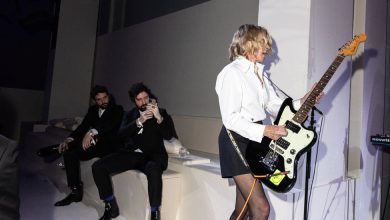A Daughter’s Reclamation of Her Father’s Past

In each installment of The Artists, T highlights a recent or little-seen work by a Black artist, along with a few words from that artist putting the work in context. This week, we’re looking at “FBI Drawings: Unknown” (2021), a diptych done in powdered graphite and colored pencil by Sadie Barnette. Known for incisive, labor-intensive prints and installations, she reimagines her familial history in her latest show, “Sadie Barnette: Inheritance,” on view at Jessica Silverman Gallery in San Francisco until Jan. 8, 2022.
Name: Sadie Barnette
Age: 37
Based in: Oakland, Calif.
Originally from: Oakland, Calif.
Where and when did you make this work? I made this diptych a few months ago in my studio. It’s in a beautiful old building that’s been in the same family since the ’70s. The neighboring studios are used by a ceramist, a glassworker and a letterpress, and there are chickens in the back. It’s a relic of the past and feels like it’s from a different universe than that of the giant condo building across the street. So many artists are getting displaced and having a hard time finding affordable studios right now, but I’ve been really lucky.
During the pandemic, drawing with graphite has become a way to do something meditative that keeps me from spiraling off the face of the earth. I do it on a really large scale, and the process is painstakingly slow. I’m not exactly sure what’s going to make the world more functional and caring, but I know that if I can do something with my hands in a day, it’s a way to believe in something. It’s almost spiritual.
Can you describe what’s going on in the work? It’s made from two pages of the 500-page surveillance file that the F.B.I. amassed on my father, Rodney Barnette, who, in 1968, founded the Compton chapter of the Black Panther Party. My family filed an F.O.I.A. request in 2011 and about five years later, we finally received the dossier.
The folder is at once chilling, emotional, disturbing and violent. Surveillance sometimes sounds like an innocuous information-collecting process, but it’s often harassment, intimidation and agent provocateurs. In 1969, because of his political activism, my father was fired from his job at the post office. My initial reaction to these documents was: One, this is terrifying, and two, I’m lucky that my dad lived and I’m lucky that I’m alive. I thought, How can I reclaim this material? How can I highlight my father and our family history, which is the history of so many other families in this country? So the work is definitely about reclamation and repair to some degree, but it doesn’t intend to fix the harm per se. It’s more about a journey of repair. Or about repair as a practice, a meditation.
I created a giant stencil, a machine cut it out, then I laid it onto paper and brushed graphite over the surface. The result looks like a carbon copy. There’s a ghostly element to the white-on-black text. I’m always careful to interact with the source material but not to compete with it — or change any of the factual information.
At 4 by 5 feet, the diptych is pretty large. I really wanted it to confront you on a human scale. The first panel shows a page dated May 25, 1972. It’s from a time when the F.B.I. essentially lost my father. I love this slippery moment of the unknown. The page says “residence unknown” and “employment unknown.” The agency later found his address because it had been monitoring subscriptions to “The People’s World,” the communist newspaper.
The second panel is a mug shot, which looks almost like a screen-printed political poster, because the photograph had been photocopied and re-photocopied so many times. I was thinking about how mug shots instantly criminalize and dehumanize someone, how they turn them into a number. I imagined this photo on hundreds of F.B.I. desks, and how, to its agents, my father was an expendable person, an “extremist.” My experiment was: If I draw this image by hand, through some alchemy of love and labor, can I turn it into something else? Can I turn it into a portrait of a father daring to imagine a new world? It was really gratifying to draw the roses in colored pencil. The colors pop against the graphite in a way that makes the blooms look like stickers. I was thinking about domestic spaces and rituals of care, how we give each other flowers to say “I love you” or at funerals to mourn and memorialize loved ones.
What inspired you to make it? My work interrogates thepolitical structures that we live under, but I’m also always dreaming of what exists beyond these systems. It’s important to understand the systems that we exist within, but also not to let them limit our imaginings of other ways that humans could be.
When I was growing up, my father didn’t talk about his time in the Panthers. I don’t think he had any idea that the F.B.I. file would become part of my practice, but the fact that it did hasgiven him a sense of freedom, which is the highest aim I could have had for my work. If I can make my 77-year-old father — who was drafted and sent to Vietnam, who’s been abused by the police half a dozen times, who has fought and defended farmworkers and union organizers and who has been trailed by the F.B.I. — feel free in this country for just one moment, that’s all that I could ask for.
What’s the work of art in any medium that changed your life? Toni Morrison has changed my life multiple times. I read her first novel, “The Bluest Eye” (1970), in high school and “Song of Solomon” (1977) is one of my very favorite books. For a long time, I was afraid to read “Beloved” (1987) — I had a hard time facing it. But I finally read it during the early days of the pandemic and once again, I was changed.
This interview has been edited and condensed.



